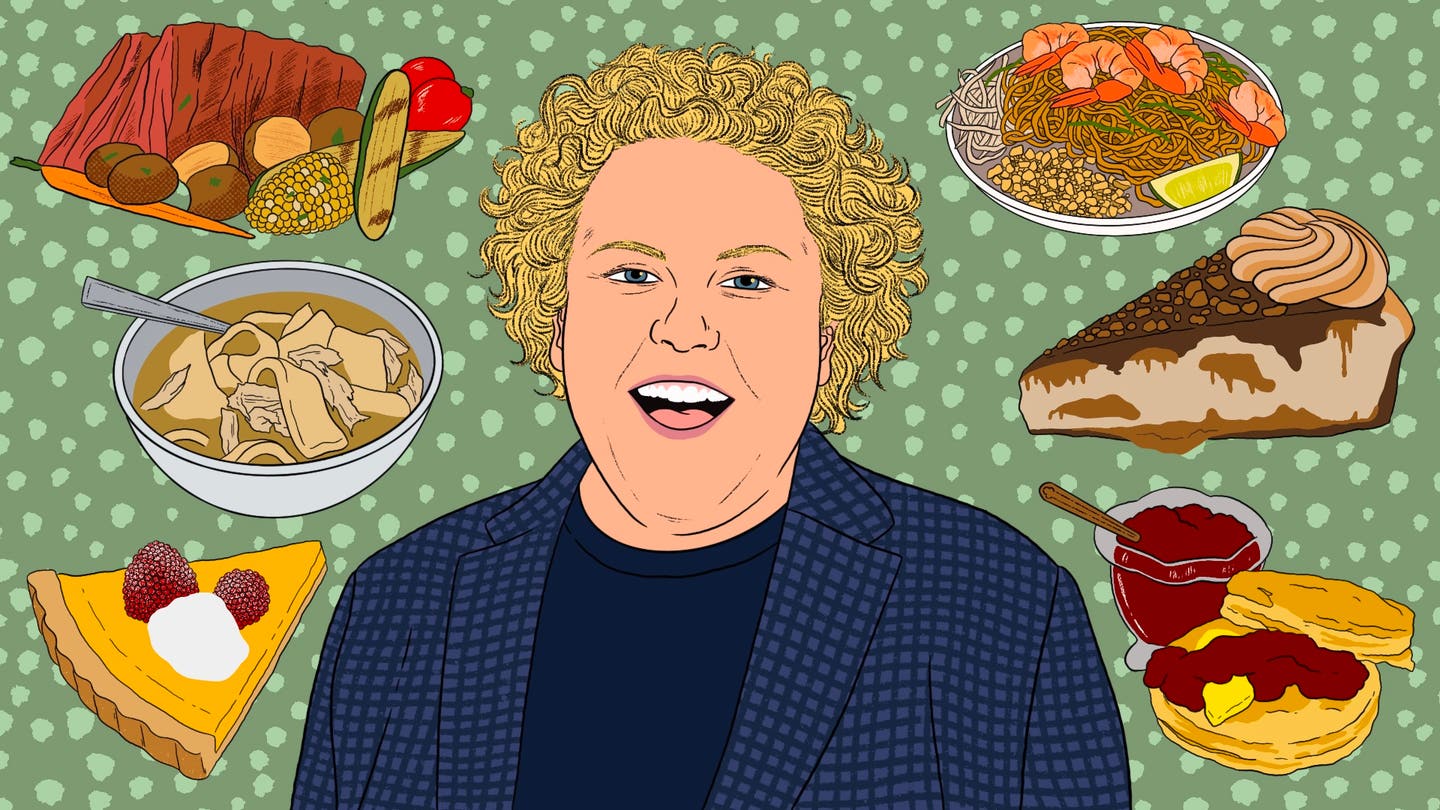
Easy Being Green
There are few subjects that people take as personally as what other people are eating—or not eating. I've experimented with vegetarianism, on and off, since I was a teenager, and during a recent "on" phase, which lasted about eight years, I was struck by the intense interest people showed in my diet. There was the friend who fretted every time we made dinner plans: "But what will you eat?" There were the hosts, otherwise capable cooks, who prepared ominously beige, flavorless nut loaves specially for me. (I'd have settled, happily, for any of the far more appealing vegetable side dishes on the table.) And then there were fellow diners who, after a couple of glasses of wine, would suddenly blurt out, "Aha! I see you're not above wearing leather shoes." The forgoing of meat puts a lot of people on the defensive, and yet, if a recent wave of easygoing vegetarian and quasi-vegetarian cookbooks is any indication, we may be in the midst of a sea change.
It's been a long time coming. Unlike in many parts of the world, where remarkably vibrant vegetarian cuisines have developed as a result of necessity or religious observance or both, in the West purposeful abstinence from meat has traditionally been associated with asceticism. Until the mid-19th century, in fact, when the word vegetarian was popularized by the British Vegetarian Society, those who eschewed the eating of animal flesh were widely known as Pythagoreans, after the sixth-century B.C. Greek mathematician Pythagoras, who is said to have accepted into his circle only scholars willing to commit to the discipline of a meatless diet. In 1812 the first known vegetarian cookbook, Vegetable Cookery, was published in England by one Martha Brotherton, a member of a sect called the Bible Christians whose self-denial extended to alcohol as well as meat. Beginning in the 1830s, the American minister and dietary reformer Sylvester Graham (of cracker fame) preached vegetarianism as an antidote to both alcoholism and lust; his ideas, in turn, influenced the breakfast cereal innovator John Harvey Kellogg, who promoted a high-fiber vegetarian diet at his famous sanitarium in Battle Creek, Michigan. A penitential strain in vegetarian food survived, on both sides of the Atlantic, until well into the 1970s, by which time it had been taken up by the hippie counterculture and become entrenched in the popular consciousness as a regimen that was as cheerless as it was meatless.
Perhaps it's fitting that a fresh take on vegetable-centered cooking first emerged in the hippie heartland itself, San Francisco. In 1979 a Bay Area chef named Deborah Madison (now a SAVEUR contributing editor), who had spent time in the kitchens of both the San Francisco Zen Center and the legendary Berkeley restaurant Chez Panisse, opened Greens, a restaurant that, in her words, "set out to create a [vegetarian] cuisine whose complexity and interest left the diner feeling that nothing was missing". With dishes like tagliatelle, asparagus, and peas with saffron cream and Provençal potato gratin with olives and lemon thyme, Madison bridged the divide between a principled commitment to eating compassionately and a decidedly sensuous approach to food. She went on to write a number of successful vegetarian cookbooks, reaching out to her widest audience yet in 1997 with the ambitious Vegetarian Cooking for Everyone, which has been called by some devotees a meatless Joy of Cooking. The recently published tenth-anniversary edition (Broadway Books, $40) shows just how prescient Madison's masterwork was. When I revisited her recipe for brussels sprouts with mustard butter and caraway, I was impressed by her intuitive knack for showing off farm-fresh produce, that cornerstone of today's organic, eat-local ethic, to its best advantage. The mustard and caraway chimed perfectly with the sprouts' kick, while the butter tempered their more astringent qualities. It takes a deep affinity for the ingredients at hand and an unabashed love for rich flavors to produce a dish that is at once so simple and so striking.
Over the years, I've found that my intermittent vegetarianism, far from limiting my options, has actually broadened my palate and—thanks to enlightening books like Madhur Jaffrey's World-of-the-East Vegetarian Cooking (Knopf, 1981)—my knowledge of many non-Western cuisines. When I found vegetarian cookbooks lacking, I didn't hesitate to plunder and adapt vegetable recipes from otherwise meat-centric sources, including, with some regularity, How to Cook Everything (Wiley, 1998), the exhaustive book of basics by the New York Times columnist Mark Bittman. Now, in acknowledgment of vegetarianism's vastly expanded appeal and repertoire, Bittman has come out with How to Cook Everything Vegetarian (Wiley, $35). The book is a thorough primer on meatless cookery, crammed with helpful charts and sidebars like "Six Simple Additions to Cooked Beans" and "Vegetarian Thickeners at a Glance". Just as he did in his earlier volume, Bittman suggests appetizing variations for nearly every one of the book's more than 2,000 recipes; a classic (and delicious) macaroni and cheese made with sharp cheddar, for example, becomes a considerably more opulent dish with the addition of mascarpone and wild mushrooms.
Bittman, who has not personally forsaken meat altogether and who sees his book as merely a road map to help guide readers in the direction of a more heavily plant-based diet, is responding to a trend that's been gathering force over the past 15 years or so. Americans are eating more vegetables than ever, thanks to myriad factors: the number of farmers' markets in this country has surged, for one thing, and in many restaurants traditional meat entrees have given way to more-varied small plates. A neologism,_ flexitarian_, has even been coined to describe the sort of eater who adheres to a largely vegetarian diet while still savoring the occasional serving of meat, fish, or poultry. In The Flexitarian Table (Houghton Mifflin, $30), Peter Berley, a former chef at the New York City vegetarian mecca Angelica Kitchen, who earned praise for an earlier book, The Modern Vegetarian Kitchen (HarperCollins, 2000), makes this way of eating look like a balanced and sensible way to live. Berley is especially convincing because he's actually lived this way for years, creating meals to accommodate himself, his wife, and his young daughter, all of whom occasionally eat meat, as well as his older daughter, a strict vegetarian.
What's remarkable about Berley's book, apart from its deft juxtapositions of fresh ingredients and complementary flavors from different world cuisines, is its utter accessibility. It has nowhere near the number of entries found in either Madison's or Bittman's book, and that comes as something of a relief. With color photographs throughout, a seasonally based structure, and helpful menu suggestions, this is a book I've found myself hungrily returning to again and again. Preparations like the shaved vegetable and apple salad, a bracing, earthy mix of fennel, apples, radishes, and sunchokes, all sliced paper thin, are unfussy and versatile enough to pair with meat—a boon for those who don't inhabit the extremes of the carnivore-herbivore continuum.
I'll confess that the purist in me—the one who endured the nut loaves and worse in the name of avoiding meat—finds something wishy-washy in all this big-tent vegetarianism. After all, long before the flexitarians decided to think twice about where their food came from, the unglamorous duty of raising consciousness about the environmental and ethical depredations of heedless carnivorism fell upon a hard core of committed vegetarians and vegans (those who reject not only meat, fish, and fowl but also milk, eggs, honey, and any animal-derived food). Maybe that's why I felt more than a little glee on reading Veganomicon (Marlowe & Company, $27.50), an exuberant and unapologetic vegan cookbook by Isa Chandra Moskowitz and Terry Hope Romero, who express this lament in their introduction: "Why nobody believes us when we mutter things about sacrificing beets under the full moon, we'll never guess."
Veganomicon calls to mind another recent rejoinder to the dour stereotype of veganism, Skinny Bitch in the Kitch (Running Press, $14.95), by the cheekily foul-mouthed duo Rory Freedman and Kim Barnouin. Whereas Skinny Bitch is a diet book, though, Veganomicon is anything but. Moskowitz and Romero's recipes don't skimp on fat (of the nut-, seed-, and plant-derived variety) or flavor, and the eclectic collection of dishes is a testament to the authors' sincere love of cooking and culinary exploration. The selections range from cholent, a Jewish stew traditionally served on the Sabbath, to gazborscht, a spicy, Spanish-inflected version of the classic eastern European chilled beet soup. I won't deny that the scrupulous veganism to which the recipes adhere dampened my enthusiasm for certain dishes: the unwelcome taste of margarine, for example, marred an otherwise delicious cauliflower and mushroom pot pie with black olive crust. But then, the authors aren't trying to please all the people all the time. And, though I might make the personal choice of trying out that recipe using butter, it's partisans like Moskowitz and Romero who continually challenge me to approach such choices thoughtfully.
Keep Reading
Continue to Next Story










